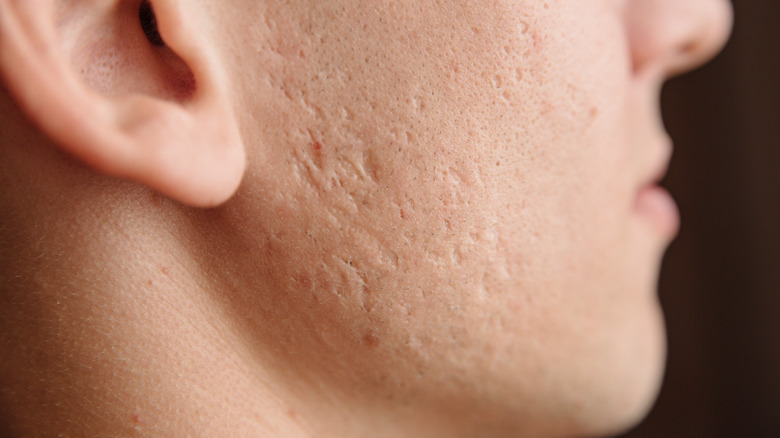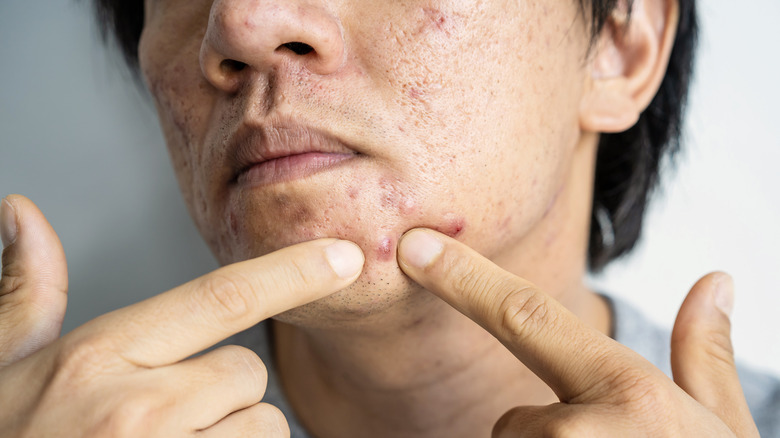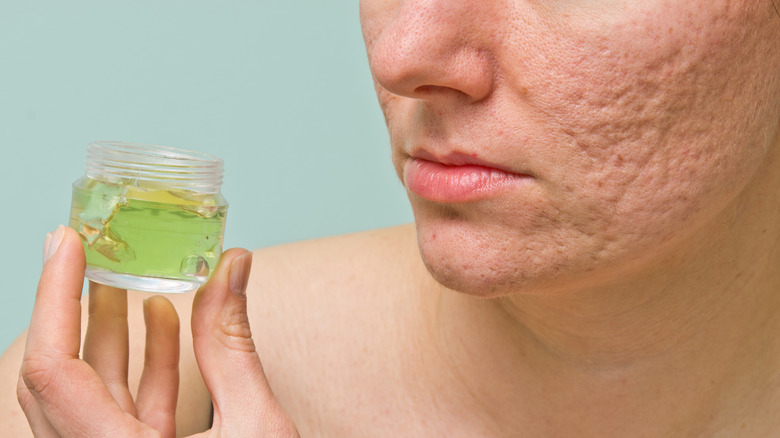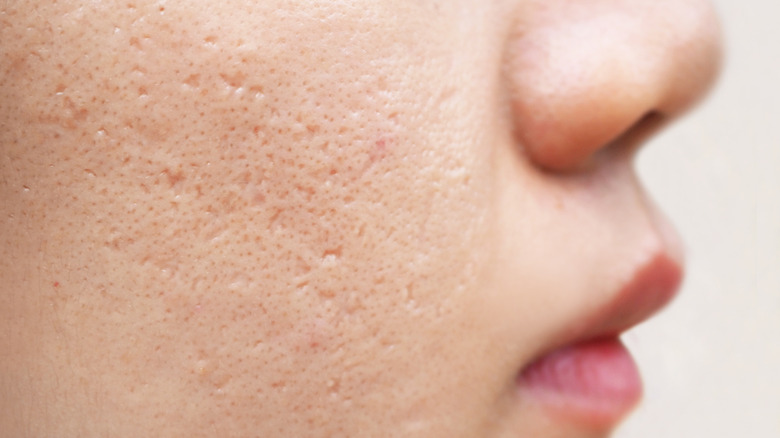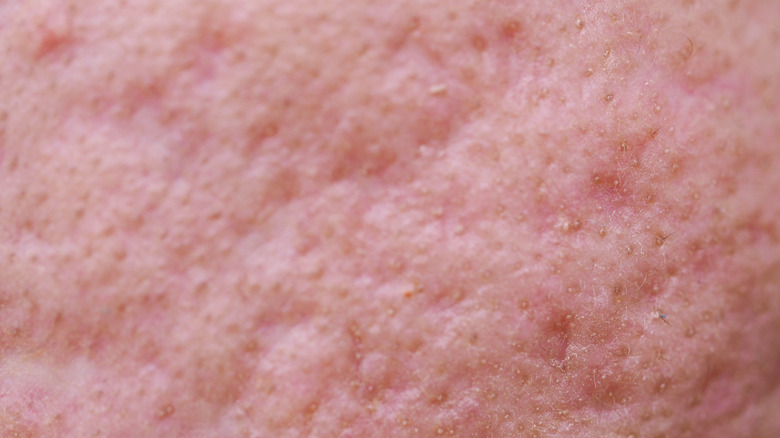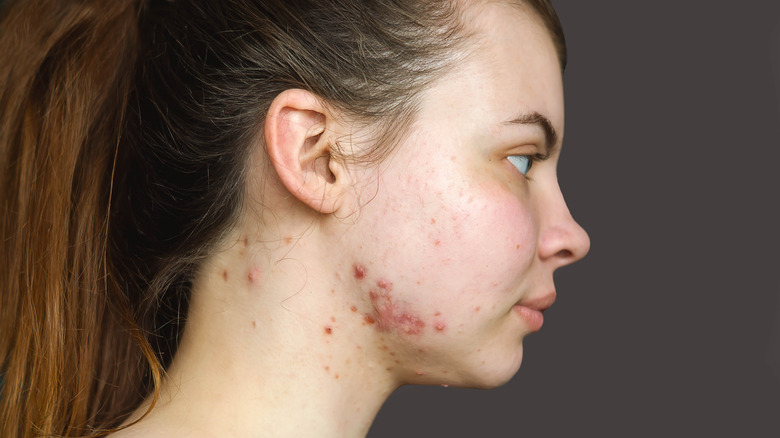How To Treat Different Types Of Acne Scars
According to the American Academy of Dermatology Association (AAD), acne affects about 50 million Americans every year. The condition occurs when hair follicles under the skin become plugged with oil (via the Mayo Clinic). Although acne is common in teenagers, it can also occur in adults and might continues into your 30s and 40s, according to the AAD. Acne symptoms usually include cystic lesions, whiteheads, pimples, nodules, and small red tender bumps, per the Mayo Clinic. Some of these symptoms are mild, while others are severe, causing scars that may leave you dissatisfied with your skin, especially during acne flare-ups.
In a 2022 study published in the American Journal of Clinical Dermatology, nearly 68.4% of people with acne associated sadness with their scars, indicating these marks can significantly affect a person's quality of life. According to a 2015 study published in The Journal of Clinical and Aesthetic Dermatology, acne scars result from a permanent complication of acne vulgaris, and it occurs early in about 95% of people. Despite testing various treatment options, only a few have been deemed effective without problematic side effects, per the study. Therefore, it's crucial to seek treatment early.
According to Healthline, acne scars come in three types: atrophic, hypertrophic, and keloid scars. As the types of acne scars differ, the treatment options will also vary.
What are atrophic acne scars?
Atrophic scars are divided into three categories: boxcar, ice pick, and rolling scars. You're more likely to develop atrophic scars after a chickenpox attack, a bad acne episode, or a mole removal surgery, says Healthline. Atrophic scars always occur when too few new connective tissue fibers are formed during wound healing to completely fill the wound gap. The cause is often a prolonged inflammatory reaction, which occurs in instances of severe acne. The permanent inflammation leads to the destruction of deeper skin structures, which results in a loss of substance (via Healthline).
Some effective treatment options for atrophic acne include chemical peels, laser therapy, microneedling, and punch excision (via Healthline). However, each treatment has its mechanism of action and comes with its pros and cons. Some won't completely eliminate your scars, while others may leave you with new scars. For example, punch excision requires the doctor to cut into your skin before removing the atrophic acne scar and closing the wound with stitches (via the American Society for Dermatologic Surgery). The procedure may leave behind smaller, lighter scars compared to the original, per the association.
Boxcar scars
According to MedicalNewsToday, boxcar scars — also known as craters or pockmarks — can be triggered by chickenpox or severe acne. Apart from having chickenpox or severe inflammatory acne, like nodules and cysts, you may be at risk of boxcar scars if you pop or squeeze acne blemishes before they heal.
The efficacy of boxcar scar treatment depends on your skin type, the scar's redness, depth, and location (via Healthline). Usually, boxcar scars look like round or oval indentations on your skin, and they typically have sharp vertical edges. The deeper the scar, the more challenging it becomes to treat, per Healthline.
According to WebMD, treatment options for boxcar scars may include fillers, microdermabrasion, and laser therapy. Fillers, which come in temporary, semi-permanent, and permanent options, are injections that fill out indented parts of your skin. These injections help your skin produce more collagen, improving the appearance of the affected area, per WebMD.
Microdermabrasion involves removing the skin's very top layer where dead cells are (via MedicalNewsToday). This encourages collagen production, especially for shallow scars. Dermabrasion, which involves removing the skin's entire top layer, can be effective for deeper boxcar scars but may cause skin soreness and sensitivity. Laser therapy involves using targeted pulses of light energy to encourage collagen production and fast-track healing.
Ice pick scars
Due to the depth and narrow impressions of ice pick scars, they can be difficult to treat at home with widely available drugstore products (via Healthline). They usually have a sunken appearance, as if the skin was punctured by a tiny ice pick, says WebMD. Furthermore, they appear after acne is cured, and the scars left behind are often less than 2 millimeters wide, per WebMD. According to the source, various hygiene choices can increase your risk of ice-pick scars. They include scrubbing the skin and using abrasive cleaners.
According to MedicalNewsToday, treatment options include punch excision, which removes the top layers of the affected skin and stitches it back, allowing the area to heal. Your dermatologist might also recommend punch grafting, which is a similar treatment that works best for removing deeper ice-pick scars. Unlike punch excision, the affected area isn't stitched after removal. Instead, the removed scar is replaced with a part of your body to facilitate smooth, even restoration.
Chemical reconstruction, where a high-strength acid is applied focally, is another effective treatment option for most atrophic acne scars. This may be especially effective for ice pick scars, according to a 2021 study published in the Journal of Cosmetic Dermatology. More than 60% of patients showed 25% improvement, per the study.
Rolling scars
According to Healthline, rolling scars have rounded, sloping, and irregular edges, making the skin look uneven. They are usually caused by bands of scar tissue that have formed under the skin, per the National Health Service (NHS). They often appear on the lower cheek, jawline, and other thick-skinned areas, showing unconcealable dents or pits between 4 and 5 millimeters in size, according to MedicalNewsToday. People with rolling scars may be susceptible to other acne symptoms, including discoloration or raised marks.
Rolling scars affect people differently. While some people may experience fading over time, a 2010 study published in the journal Dermatology Research and Practice establishes that these scars don't completely heal without treatment. Depending on how severe your case is, your dermatologist may recommend clinical or surgical alternatives to treat rolling scars.
Usually, the deeper the scar, the more challenging it is to find an effective treatment, says WebMD. Your age, the type of scar, and medical history are a few factors that can determine the efficacy of a particular treatment option, according to the source. Rolling scars can respond positively to general acne treatments like chemical peels, dermabrasion, and microdermabrasion cryotherapy.
Hypertrophic and keloid scars
According to the Cleveland Clinic, hypertrophic and keloid scars are raised growths caused by abnormal wound healing. Although similar, the scars can be differentiated by the degree to which they surround the original wound. Hypertrophic scars are characterized by extra connective tissues that form within the original wound and stay within that area without spreading. In contrast, the connective tissues from keloid scars extend beyond the original wound, says the Cleveland Clinic.
The time it takes for both scars to develop and their responsiveness to treatment are other ways to differentiate between them. Hypertrophic scars develop within 1 to 3 months after a deep skin injury or surgery, while keloids need about 12 months to show symptoms after an injury, according to a 2017 study published in the journal Frontiers in Medicine. Hypertrophic scars and keloids may respond to similar treatment options, but the former is more responsive to treatment and less prone to recurrence, per the study.
According to the Mayo Clinic, compression dressings are usually the first treatment option for newer keloids. They're used after surgical removal of the keloid to exert pressure on the wound as it heals. During the healing process, a corticosteroid cream might be prescribed to help ease itching. Other treatment options for keloids include scar freezing, laser, and radiation therapy. Corticosteroid treatments are also effective for hypertrophic scars, according to Healthline. Another option is bleomycin, which can be directly injected into the scar.

